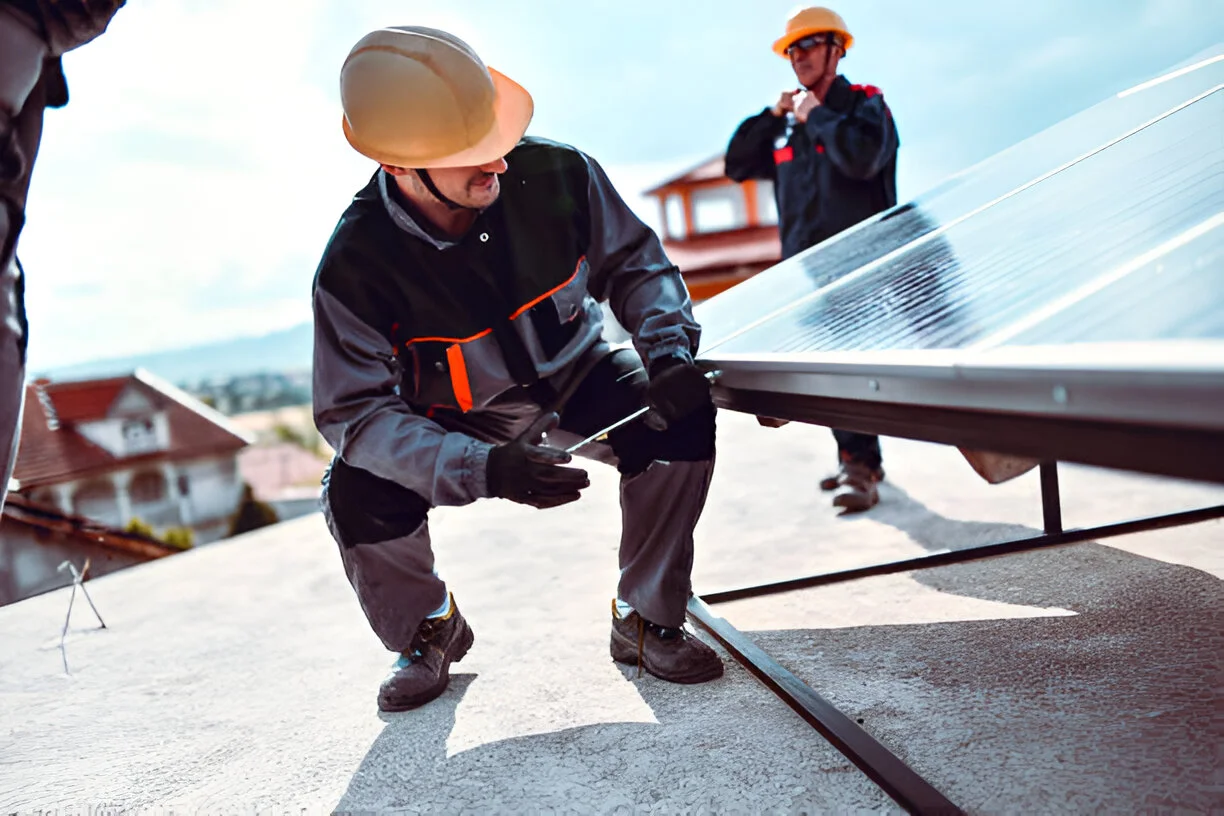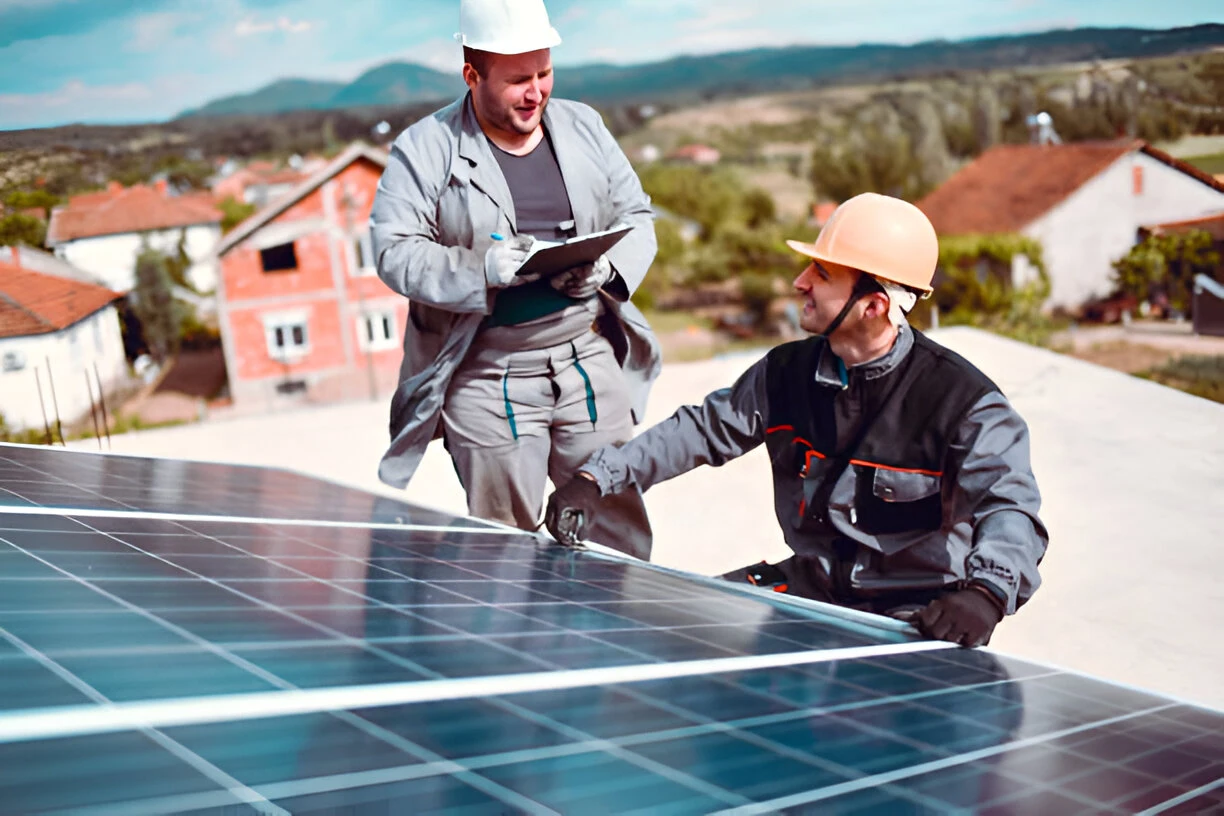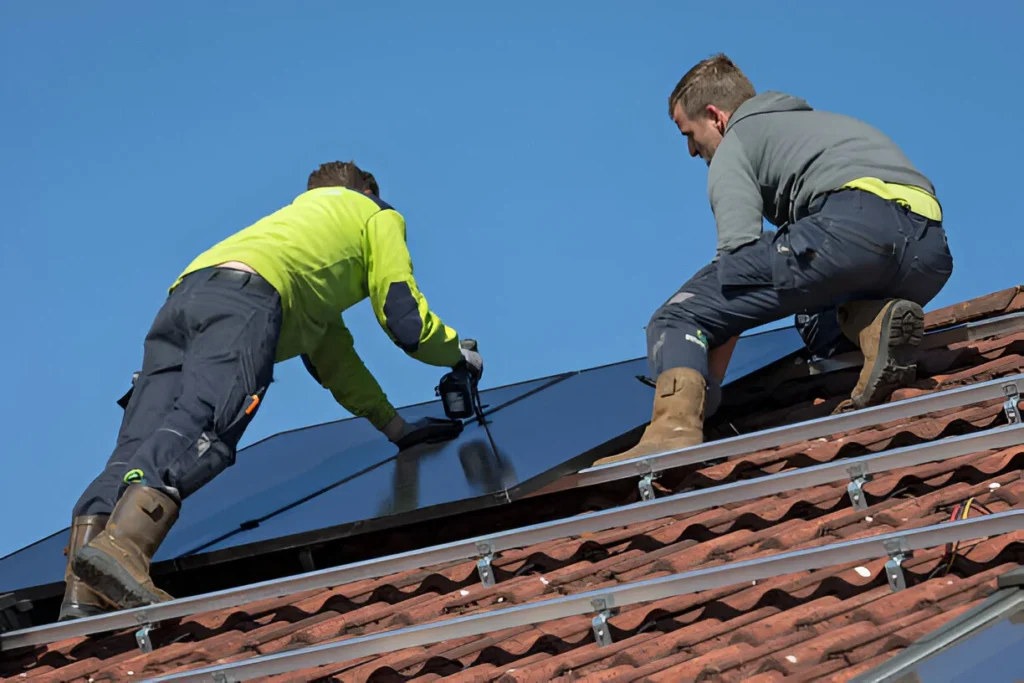The increased need for locally sustainable renewable forms of energy has seen solar energy become a popular alternative for both households and companies worldwide. Flat roof solar installation is highly popular with different forms of installations owing to its flexibility as well as urban-dense compatibility.
If you either own a flat roof or intend to put solar panel installations on a roof, being familiar with the principal flat roof solar installation aspects makes it easy for you to be a fully informed decision-maker and take full benefit from solar investment.
What is Flat Roof Solar Panel Installation?
Flat roof solar installation describes solar roofing with minimal pitch. In contrast with pitched roofs, flat roofs are made up of a flat surface that demands a special racking material for installing solar panels with a tilt for optimum exposure to solar radiation. Flat roof solar installation is prevalent with commercial businesses, apartment units, and contemporary houses.
Their installations also involve installing racking systems to hold up the panels in their sites that otherwise would comprise tilt functions. The systems make sure that the panels remain stable, long-lasting, and tilted for optimum production of solar power.
Benefits of Flat Roof Solar Installation
There are several advantages that flat roof solar systems provide that make them highly preferred for most owners.
Another advantage is panel orientation flexibility. It being a flat roof allows solar panel installers to easily pitch and tilt the solar panel direction for exposure to sunlight from the sun. This aspect isn’t that practical with fixed-pitch roofs.
Flat roofs also usually allow for more usable space so that bigger solar installations that generate more electricity can be mounted. Flat roofs also usually allow for easy access so that cleaning and panel maintenance are facilitated.
Since panes sit on raised racks from ground level, flat roof solar systems generally steer clear of roof structure-associated shade that might be created by vents or chimneys. This creates a more effective system.
How do Solar Panel Systems on a Flat Roof Work?
Whereas on-roof Solar PV systems follow the pitch of the existing roof, flat roof systems require the installer to set their pitch. This is great, as it means that your system can be designed for optimal solar generation.
The ideal pitch for a Solar Panel is around 30 degrees off the horizontal. Simply because this allows the panels to gain more exposure from the sun throughout the entire day. When installing solar panels on a flat roof, this is easily achieved. As the Solar Panels are installed onto a bracket that tilts the panel to around 30 degrees.
Flat Roof Solar panels are usually mounted onto a tub and weighed down by ballast (gravel, paving slabs, bricks, rocks, etc) to resist high winds. Alternatively, the panels are mounted onto metal frames. This is usually determined by the building structure and location.
Types of Mounting Systems for Flat Roof Solar Panel Installation
There also exist different racking systems for solar applications for flat roofs that specifically apply to different constructions of roofs, along with racking applications.
One of these extremely popular installations is ballasted mounts. Ballasted mounts make use of heavy ballasts that hold solar panels without puncturing roof surfaces. This ensures roof surfaces remain immune to perforation damage and is selected for roofs with warranted restraints.
Through-penetrating mounts entail attaching the racking system to the roof structure itself with bolts or screws. Although this style enjoys increased stability for installations with a requirement for significant wind stability, it must be adequately waterproofed to avoid leaks.
Tilt-up racks usually go with ballasted tilting mounts for tilting the panel to an optimum angle. Both tiltable and fixed racks are available for simple seasonal tilting for optimized energy production.

Things to Consider Before Installing Solar Panels on a Flat Roof
Solar Panels. Some critical factors must be assessed before installing flat roof solar. One must then evaluate one’s roof bearing capacity and condition. A roof supporting system with installed roofing panels weighs down a roof, so it must be a robust roof that can bear installation without a problem. Then evaluate roof space with potential shade from adjacent buildings or vegetation. Even small shadows significantly reduce solar panel efficiency.
Keep weather conditions in mind. Flat roof ballast applications require minimal weight to deal with heavy wind conditions, particularly for sites that encounter hurricanes. You must also check with municipal building codes and obtain any permits for installation. A limited number of towns need rooftop solar installation under special considerations.
Installation Procedure in Detail
The installation of solar for flat roofs is mostly about these next steps:
Firstly, a location analysis for a suitable place and an energy analysis are done for locations to find out the optimum panel quantities. Then, a mounting system is constructed and tailored exactly for that kind of roof.
Then panelling along with racks, with a proper tilt and alignment set. The electrical connection, once installed, includes connecting to a grid or to a building electricity system as well as connecting to an inverter with the panels.
And finally, it is put under examination and trials so it meets safety standards as well as functions effectively.
Common Problems and How to Deal with Them
One of the most common characteristics that is true particularly for flat roof solar installation,n is water draining. Flat roofs need good drainage systems so that no water remains near the solar panel support, which will damage roof membranes.
Another concern is ballast weight. Excessive ballast might put excessive strain on the roof structure, while not enough might not hold the panels firm enough under heavy wind conditions. It is possible to strike a balance with a visit from a structural engineer.
Their panel cleaning is also made difficult if installed too close together, so that they cannot be easily cleaned. Planning and spacing must be carefully done when installing.
Tips to Maximize the Efficiency of Your Flat Roof Solar System
Properly tilted orientation creates a max solar energy. Solar boards for the majority of conditions need to be facing true south (for Northern Hemisphere locations) with a tilt near the latitudinal tilt of a spot. Cleaning solar panel surfaces regularly to remove dirt, debris, and dust will enhance efficiency by up to 20 percent, based on research.
The use of good-grade inverters and installing tracking systems for tracking electric production allows for early identification of issues and optimization of production for systems. By installing solar along with electricity-saving technologies like LED bulbs and electricity-saving appliances, your entire consumption of electricity will be reduced even further.
Benefits for the Environment
The installation of solar panels on a flat rooftop is a crucial factor for reducing carbon emissions. Solar power is a sustainable source of electricity that produces no greenhouse gas while it is in use.
Economically, solar power systems lower electricity expenditures while raising property value. Incentives in terms of tax credits, rebates, and net metering programs also make solar more attractive and affordable.
As reports from the U.S. Energy Information Administration indicate, solar production from America has increased considerably, a clear indication of its growing economic competitiveness.

How to Prevent Flat Roof Solar Panel Installation Errors
Don’t choose the lowest-priced equipment without considering quality and warranty. Low-grade panels and mounts will be prone to early failure.
Omission of the correct analysis of the structure before installation may result in damage or hazards that become costly.
Not securing permits that one needs or ignoring what a town prohibits will stall it or freeze it.
Not considering future growth or battery storage might restrict your system’s long-term potential.
Real-Life Scenarios of Successful Flat Roof Solar Panel Installation
Certain companies, as well as household owners, have benefited from flat roof solar systems. A California commercial warehouse benefited from installing a 100 kW solar photovoltaic system on a flat roof. This decreased annual energy expenses by 75 percent. Residential buildings in urban sites with restricted roof space for pitch roofs applied flat roof solar configurations for the least solar radiation utilization. These applications generate usable value and long-term savings obtained with carefully conceived flat roof solar applications.
Conclusion: Is Flat Roof Solar Installation Right for You?
Flat roof solar installation is one of the most popular, effective, and flexible forms of going solar. Its strengths for flexibility with orientation, space usage, and service access allow most forms of property. By becoming acquainted with technical considerations, installation procedure, and possible complications, you’re much better prepared to make a solar system investment that aligns with your energy demands.
Soaring energy prices combined with green being a mandate make solar power adoption with flat roof installation a smart strategy toward energy independence as much as it is environmentally friendly. Look into your alternatives, seek advice from experts, and move one step closer to turning your flat roof into a solar energy pioneer.


